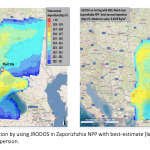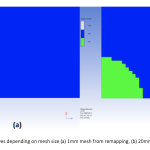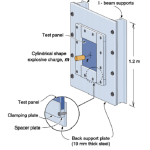| Title | Pages |
|---|---|
| Preface |
Preface |
| The Role of Thermotropic Liquid Crystals in the Detection of Gases that Adversely Affect the Nervous System In this study, the aim was to develop an innovative and user-friendly sensor capable of quickly detecting the gases phenol, toluene, and 1,2-dichloropropane, which negatively affect brain functions when inhaled over extended periods. To achieve this, the thermotropic phase of liquid crystals, which possess thermotropic and lyotropic phases, was used, and a thermotropic cholesteric liquid crystal (CHLC) sample was formulized. The changes occurring in the presence of these gases were examined optically. In this context, the thermotropic ChLC sample, composed of E7 thermotropic liquid crystal and a chiral mixture made from chiral dopants CB15, R1011, and R811, was placed into a cell created using the sandwich method with glass surfaces modified with lecithin. The mentioned gases, evaporated at different temperatures, were introduced into the cells containing the liquid crystal sample over varying durations, and the resulting changes in the wavelength of the liquid crystal were analyzed. Thus, it was demonstrated that these gases, which have a detrimental impact on human health, can be detected at the lowest concentration levels using a sensor containing thermotropic liquid crystal. 


|
297 - 303 |
| Impact of Uncertainties of Nuclear Severe Accidents on Radiological and Nuclear Dispersion Predictions Protection of the public as well as the environment is primal task of the regulators and provisions to sustain integrity of the plant have been developed. In addition to that, the consequences of possible severe accidents are necessary to develop strategies to mitigate the impact. Evaluation by using severe accident tools is common practice accepted by regulators, but these tools rely on models that generated by using limited experimental data. Thus, reliable evaluation of the accident also requires uncertainty quantification of the results. In this work, selected accident case on VVER-1000 is performed by using ASTEC tool and the uncertainties of the ASTEC code is quantified by using KATUSA tool with the goal of determination of the potential impact range. 100 samples are generated according to selected uncertain parameters, their probabilistic distribution functions (PDFs) and variation range, and multiple ASTEC code simulations are performed to evaluate the results. Finally, JRODOS calculation is performed on Zaporizhzhia NPP with worst-case and best-estimate scenarios to identify the difference on the radiological impact. The potential difference on the inventories results with almost two times higher radiological contamination of the selected area on selected period which causes almost 1.5 times higher doses on the population. 



|
305 - 314 |
| Zebrafish (Danio rerio): A Pioneer Model in Medical Chemical Defense Researches Preparing the highest level of preparedness plans and treatment procedures against the adverse effects of chemical warfare agents (CWA) is the most important component of chemical defense. Currently, the zebrafish (Danio rerio) model, which exhibits superior qualities compared to rodents for evaluating CWA effects, is the most important subject of this study. An overview of the zebrafish model and existing research using this model in CWA studies is presented. The anatomical and physiological features of the zebrafish have made it a popular model organism. Literature studies have shown that the zebrafish model is a versatile model for observing the effects of CWA. 



|
315 - 324 |
| Investigating the Effects of Remapping Method in Explosion Using real explosives to detect explosion effects is a difficult and impractical method due to its danger and cost. Performing numerical analyses based on previously conducted experimental studies allows for the diversification of studies on this subject. Since the elaboration of numerical analyses causes an increase in the amount of processing, it requires the devices that need to perform these operations to be very advanced. It is an important optimization that the solutions are shorter and closer to reality, and this can be done with the remapping method. With this method, the explosion loads obtained from 1D analysis can be integrated into 2D and 3D analyses with certain methods, and the duration of these analyses is reduced and their accuracy is increased. Within the scope of this study, the methods and approaches for the application of remapping technique are explained. As a result of this study, it will help those who want to perform explosion simulations to obtain more accurate results in a shorter time with less processing power, and it will pave the way for many scientific studies to be carried out. 



|
325 - 336 |
| Novel Medical Countermeasures for Nerve Agent and Pharmaceutical Based Agent Poisoning Nerve agents are organophosphorus compounds which inhibit acetylcholinesterase (AChE) enzyme. Existing AChE reactivators (Oximes) have several limitations in mean of reactivation potential, broad action spectrum, and penetration rate through blood-brain barrier. Ongoing studies focus on design and synthesis of novel oximes. Pharmaceutical based agents like fentanyl abuse becomes an important public health threat. Naloxone and naltrexone that are centrally acting opioid receptor antagonists, are used for reversing the effects of the opioid overdose.
|
337 - 346 |
| Numerical Analysis of Explosion-Induced Deformations on Steel Panels in Urban Environments Explosion proof structures are designed to be very heavy and non-functional using conventional systems so that they can be resistant to blast effects. As a result, not only the emergence of non-economic structures, but also their operational performance decreases. To effectively mitigate these challenges, a substantial body of research has focused on the development and application of designs and materials specifically engineered to withstand explosive load impacts. In this study, the strength of steel plates under explosives with different energies was tested. Related tests were performed using Ls-Dyna finite element software. An experimental literature was used to calibrate the numerical model. When the results obtained as a result of the calibration were compared with the experimental data, a high level of agreement was obtained. The calibrated numerical model was subjected to burst loads by varying the panel thicknesses and its dynamic responses were simulated. The displacement values were analyzed by placing the explosives equidistant from the panel centers. By comparing the analysis results, explosive energies were compared. The most effective explosive types could be listed according to the amount of change that the evaluated explosives in the same amount caused on the panel surfaces. In line with these studies, information will be gained about what type of steel materials will be used against which type of explosives in areas that need to be protected in urban areas. 



|
347 - 361 |
| Fentanyl and Fentanyl Subgroups as Chemical Weapons In 2002, 130 people, including the invaders, lost their lives in a hostage rescue operation after Chechen terrorists seized a theatre in Moscow, the capital of Russia. Although remifentanil and carfentanil used by the security forces in this operation are not defined as chemical weapons by the Chemical Weapons Convention, the high number of people who lost their lives and the effect of these chemicals on the central nervous system have caused controversy in the world. In this scientific study, chemical weapons, fentanyls and sub-fentanyl groups were analysed in detail and the answer to the question of whether these opiates can be considered as chemical weapons was tried to be sought. Although the evaluation of fentanyl and its subgroups as chemical weapons is a subject of debate in the world, the fact that countries do not strictly monitor it through their own laws and do not consider it as a chemical weapon in the first place makes it unlikely that fentanyl and its derivatives can be considered as chemical weapons at this stage. |
363 - 372 |
| A Five-Day-Old Victim of Chemical Terrorism was Exposed to Sulfur Mustard Sulfur mustard (SM) is a blistering chemical warfare agent and it has cytotoxic effects on ocular, respiratory, cutaneous, and hematological systems. We presented acute hematological effects of high-dose SM exposure on a five-day-old victim who was exposed to SM in Syria in 2015, during a chemical attack. Following onset of typical ocular, respiratory, and cutaneous symptoms of SM, the patient was evacuated to Turkiye on 18th hour after the exposure with an initial diagnosis of second-degree chemical burn. The patient died on 14th day after the exposure. Severe thrombocytopenia, reactive leucocytosis followed by mild leukopenia, isolated lymphopenia, and anaemia were observed after SM exposure. Besides symptomatic treatment, granulocyte-colony stimulating factor (G-CSF), packed red blood cells transfusions, and platelet transfusions were administered for the treatment of hematological complications. Monitoring hematological indices daily, advanced medical interventions including G-GSF treatment for SM-induced neutropenia, and aggressive resuscitation with multiple blood transfusions could reduce the impact of myelosuppression in victims of SM. 


|
373 - 377 |